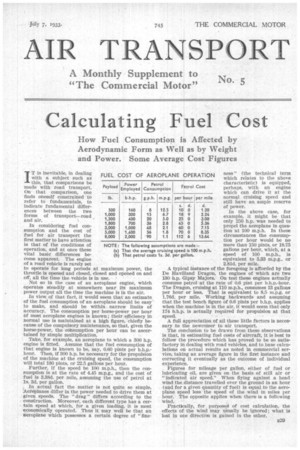Calculatin Sr
Page 47

If you've noticed an error in this article please click here to report it so we can fix it.
Fuel Cost
How Fuel Consumption is Affected by Aerodynamic Form as Well as by Weight and Power. Some Average Cost Figures
IT is inevitable, in dealing with a subject such as this, that comparisons be made with road transport. On that comparison, one finds oneself constrained to refer to fundamentals, to indicate fundamental differences between the two forms of transport—road
and air. ‘ In considering fuel consumption and the cost of fuel for air transport the first matter to have attention is that of the conditions of operation, and at once these vital basic differences become apparent. The engine of a road vehicle is rarely set to operate for long periods at maximum power, the throttle is opened and closed, closed and opened on and off, all the time the vehicle is in use.
• Not so in the case of an aeroplane engine, which operates steadily at somewhere near its maximum power output all the time the machine is in the air.
In view, of that fact, it would seem that an estimate of the fuel consumption of an aeroplane should be easy` to make, and should be within narrow limits of accuracy. The consumption per horse-power per hour Of most aeroplane engines is known ; their efficiency in normal use is maintained at a high figure, chiefly because of the compulsory maintenance, so that, given the horse-power, the consumption per hour can be ascertained by simple multiplication.
Take, for example, an aeroplane to which a 300 h.p. engine is fitted. Assume that the fuel consumption of that engine is known to be, say, 0.60 pints per b.h.p.hour. Then, if 300 h.p. be necessary for the propulsion of the machine at the cruising speed, the consumption will total 180 pints, or 22.5 gallons per hour.
Further, if the speed be 100 m.p.h., then the consumption is at the rate of 4.45 m.p.g., and the cost of fuel is 3.38d. per mile, assuming the use of petrol at is. 3d. per gallon.
In actual fact the matter is not quite so simple. Aetoplanes differ in the power needed to drive them at given speeds. The " drag " differs according to the construction. Moreover, each different type has a certain speed at which, for a given loading, it is most economically operated. Thus it may well be that an aeroplane which possesses a certain degree of " fine
ness " (the technical term which relates to the above characteristic) is equipped, perhaps, with an engine which can drive it at the normal cruising speed and still have an ample reserve of power.
In the above case, for example, it might be that only 250 h.p. was needed to propel the aeroplane in question at 100 m.p.h. In these circumstances the consumption per hour would be no more than 150 pints, or 18.75 gallons per hour, which, at a speed of 100 m.p.h., is equivalent to 5.33 m.p.g.. or 2.81d. per mile.
A typical instance of the foregoing is afforded by the De Havilland Dragon, the engines of which are two 130 h.p. Gipsy Majors. On test these engines actually consume petrol at the rate of 0.6 pint per b.h.p.-hour. The Dragon, cruising at 110 m.p.h., consumes 13 gallons per hour or less. That is equivalent to 8.5 m.p.g. or 1.76d. per mile. Working backwards and assuming that the test bench figure of 0.6 pints per b.h.p. applies when the machine is in the air, it would seem that only 174 b.h.p. is actually required for propulsion at that speed.
A full appreciation of all these little factors is necessary to the newcomer to air transport.
The conclusion to be drawn from these observations is that, in estimating fuel costs of aircraft, it is best to follow the procedure which has proved to be so satisfactory in dealing with road vehicles, and to base calculations on actual results as noted in commercial service, taking an average figure in the first instance and correcting it eventually as the outcome of individual experience.
Figures for mileage per gallon, either of fuel or lubricating oil, are given on the basis of still air or "indicated air speed." When flying against a head wind the distance travelled over the ground in an hour (and for a given quantity of fuel) is equal to the aeroplane speed less' the speed of the wind in miles per hour. The opposite applies when there is a following wind.
Practically, for purpo,seq of cost calculation, the effects of the wind may usually be Ignored; what is lost in one direction is gained in the other.




































































































